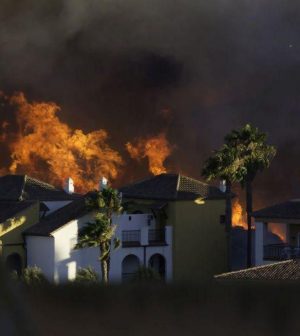- Skip Storing This Everyday Product in the Fridge Door
- Green Tea + B3 Pairing May Boost Brain Health
- Navigating Your Midlife Crisis: Embracing New Possibilities
- City Raccoons Showing Signs of Domestication
- Mapping the Exposome: Science Broadens Focus to Environmental Disease Triggers
- One Week Less on Social Media Linked to Better Mental Health
- Your Brain Changes in Stages as You Age, Study Finds
- Some Suicide Victims Show No Typical Warning Signs, Study Finds
- ByHeart Formula Faces Lawsuits After Babies Sickened With Botulism
- Switch to Vegan Diet Could Cut Your Greenhouse Gas Emissions in Half
Western Wildfires Are Making Easterners Sick: U.S. Study

You might think that wildfires in the western United States would only affect folks in places like Colorado, California or Oregon.
But a new study estimates that three-quarters of smoke-related deaths and visits to the emergency room for asthma in the United States happen east of the Rocky Mountains.
“We don’t often talk about smoke in the East,” said Katelyn O’Dell, who led the study while at Colorado State University in Fort Collins. “I wonder if there’s a lack of awareness because you think, ‘Oh, that’s a western problem.'”
While smoke does, indeed, contribute to a larger percentage of health problems in the West, it affects greater numbers of people in the East, the study authors said.
In the western United States, where the population density is lower and smoke concentrations are higher, smoke contributes to more than 1% of asthma complaints and emergency department visits in some years, according to the study.
On the more populated East Coast, where smoke levels are lower, between 0.3% and 0.6% of emergency department visits were smoke-related. But the number of emergency visits overall was higher, the study found.
The findings were recently published in GeoHealth, the journal of the American Geophysical Union.
Long-term smoke exposure results in 6,300 extra deaths each year — with about 1,700 of those deaths in the West, according to the study.
What’s inside that smoke is part of the problem. Besides toxic gases, smoke contains tiny particles called PM2.5 that enter the lungs and contribute to multiple health problems. The study also looked at 18 hazardous air pollutants (HAPs) present in smoke, such as formaldehyde and benzene.
The researchers suspect HAPs are a less important but more uncertain factor than PM2.5 in smoke-related health problems.
Short-term exposure to PM2.5 is linked to respiratory health problems, like asthma. Research suggests long-term exposure may contribute to lung cancer, heart disease and an overall higher chance of early death.
“Large wildfires are projected to increase in frequency and burned area in the western U.S. Because of that, and projected decreases in urban-sourced PM2.5, fires are expected to become the dominant source of PM2.5 in the U.S. by the end of the century,” said O’Dell, who is now a postdoctoral researcher at George Washington University in Washington, D.C.
Studying the health impacts of wildfire smoke is key to preparing for the future, she said.
While the study didn’t determine the source of smoke in each U.S. region and while some comes from wildfires in Canada, researchers called for better nationwide smoke forecasts.
Preventive steps such as alerts to people downwind, wearing masks, limiting time outdoors and use of indoor air purifiers can help reduce the health impacts, they suggested.
Tarik Benmarhnia, a climate change epidemiologist at the University of California, San Diego, who reviewed the findings, said better smoke warning systems are needed.
“The conclusion of the study is important,” he said. “We systematically underestimate the real public health impact of wildfires, which is related to smoke. And smoke can travel very, very far away.”
More information
The University of Washington studied the potential future of western wildfires.
SOURCE: American Geophysical Union, news release, Oct. 4, 2021
Source: HealthDay
Copyright © 2025 HealthDay. All rights reserved.










